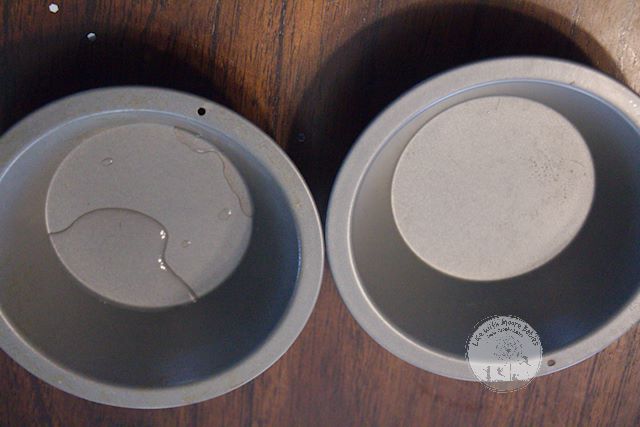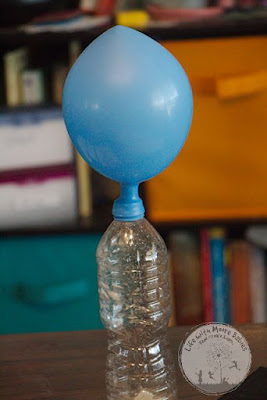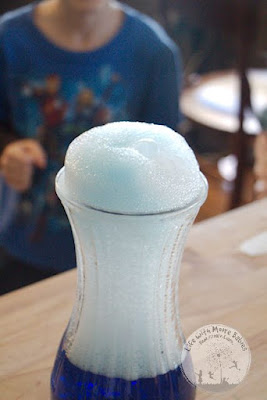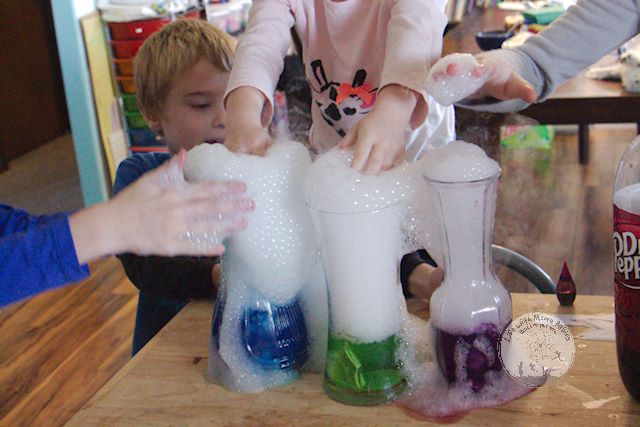Have you ever had a chance to play with dry ice? It is such an amazing substance and there are so many science activities you can do with it.
Dry ice doesn't exist in nature on earth, apparently it does on Mars, but yet many stores carry it. I suppose they sell it for freezing fish or game; we have even used it at parties to cool drinks. No matter why they sell it, they sell it which means lots of fun experiments for us!
You see, dry ice is actually frozen carbon dioxide. Yep, that stuff you breath out of your body or the stuff in your fire extinguisher, it is the same substance as dry ice, but dry ice is frozen.
A word of safety before we get to the experiments: DO NOT touch dry ice with your hands or any other body part. It is extremely cold and can burn you! Always handle with tongs!
Supplies for Dry Ice Experiments
- Dry Ice
- Normal Ice
- 2 matching pans or cups
- Plastic water bottle
- Balloon
- Dish soap
- Water
- Food coloring (optional)
- Vases
- 2 tea lights
- Lighter
- 2 clear glasses
- Small container with pop lid (medicine bottle, film canister, etc.)
This may seem like a lot of supplies, but with them you can do all the experiments in this post! Make sure you are ready to do them before you buy your dry ice though; dry ice sublimates within 24 hours of buying it even if you store it in the freezer!
Is Dry Ice like Normal Ice?
This experiment will show kids that dry ice is not made of water like regular ice. It will also show them how dry ice sublimates (turns directly from solid to gas) rather than melting.
Start with 2 matching pans. Add an ice cube to one and a piece of dry ice to the other. Notice when you lift dry ice with metal tongs it "sings" to you!
The ice begins to melt immediately. The dry ice is sublimating, but you can't see it. Give it some time while you do other experiments and go back to it.
Now you will notice the ice cube is liquid, and the dry ice is significantly smaller. Wait a bit longer and what will you see?
The liquid from your ice cube remains, but now the dry ice is gone leaving only a dry pan! All the frozen carbon dioxide has sublimated; you can see why it is called "dry" ice. Side note, sorry about the weird angle of the photo. When I took it, I didn't realize the kids had switched the positions of the pans, and I wanted it to match the above pictures!
Can Dry Ice Blow Up a Balloon
We have blow up a balloon with vinegar and baking soda, pop rocks, and of course our mouths, but could dry ice blow one up as well?
To find out, place a small piece of dry ice in an empty water bottle with a tiny bit of water (to speed it up). Pull a balloon over the mouth of the bottle.
You will notice pretty quickly that the balloon stands up as it fills with carbon dioxide. Just like the pop rocks and the baking soda and vinegar.
Wait a bit longer and you get a larger balloon! My kids were too impatient to wait for the dry ice to be completely gone before tying off the balloon, but I bet it would have become a normal size balloon!
Dry Ice Volcanoes
Baking soda and vinegar volcanoes are one of my favorite science experiments. They are so easy and dramatic! We wanted to see how dry ice volcanoes compared, and they are awesome.
Prepare your volcano for eruption by filling a container (we used clear vases) about 1/3 of the way with water, dish soap, and food coloring. The dish soap makes it extra bubbly while the food coloring just adds fun.
Now using tongs, remember not to touch the dry ice with your hands, add a piece of dry ice to each volcano. You get an awesome eruption of bubbles that produce cool smoke when popped!
This was an awesome sensory, science experiment. I can;t even tell you how many times we added more dry ice for more eruptions and more cold, smokey, dry ice bubbles!
Want to see it in action? There is a video on my instagram of the bubbly awesomeness.
Using Dry Ice to Put Out a Candle
Since dry ice is made of carbon dioxide and fire extinguishers are filled with carbon dioxide, it makes sense that the dry ice should be able to extinguish a fire.
Start with 2 tealights (or other small candles) and 2 clear cups.
Now light both candles. Slip a small piece of dry ice beside 1 candle and cover them both with the cups at the same time. We learned from another experiment that enclosing a candle limits it's oxygen and puts it out.
So would the edition of the dry ice make the candle go out quicker? After repeating the experiment many times, it was obvious that the solid carbon dioxide sublimating in the cup caused the fire to go out faster, just like a fire extinguisher.
Dry Ice Exploding Canister
It was difficult to get pictures of this last experiment, but I have included a video. You will need a container with a pop top; we used a medicine bottle that did not have a childproof lid; a film canister would work as well.
Place some dry ice in, put on the top, and wait, and wait, and wait. If you don't want to do all that waiting, and a little water before sealing the lid.
Eventually the pressure of the sublimated gas will push off the lid with a pop!
It really doesn't take any time at all if you add water.
It only takes a couple hours to do all 5 of these experiments, and the kids didn't even notice how quickly the time passed. Really if we hadn't needed to be somewhere they would have kept going! There are just so many fun, dry ice experiments!
Whether you do all of these experiments of just a couple, be sure to remember to use caution and always handle with tongs. Plus using metal tongs will get you a song!


























.jpg)
.jpg)










